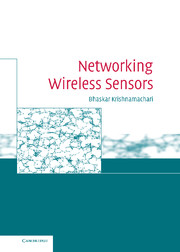Book contents
- Frontmatter
- Contents
- Preface
- 1 Introduction
- 2 Network deployment
- 3 Localization
- 4 Time synchronization
- 5 Wireless characteristics
- 6 Medium-access and sleep scheduling
- 7 Sleep-based topology control
- 8 Energy-efficient and robust routing
- 9 Data-centric networking
- 10 Transport reliability and congestion control
- 11 Conclusions
- References
- Index
4 - Time synchronization
Published online by Cambridge University Press: 14 August 2009
- Frontmatter
- Contents
- Preface
- 1 Introduction
- 2 Network deployment
- 3 Localization
- 4 Time synchronization
- 5 Wireless characteristics
- 6 Medium-access and sleep scheduling
- 7 Sleep-based topology control
- 8 Energy-efficient and robust routing
- 9 Data-centric networking
- 10 Transport reliability and congestion control
- 11 Conclusions
- References
- Index
Summary
Overview
Given the need to coordinate the communication, computation, sensing, and actuation of distributed nodes, and the spatio-temporal nature of the monitored phenomena, it is no surprise that an accurate and consistent sense of time is essential in sensor networks. In this chapter, we shall discuss the many motivations for time synchronization, the challenges involved, as well as some of the solutions that have been proposed.
Distributed wireless sensor networks need time synchronization for a number of good reasons, some of which are described below:
For time-stamping measurements: Even the simplest data collection applications of sensor networks often require that sensor readings from different sensor nodes be provided with time stamps in addition to location information. This is particularly true whenever there may be a significant and unpredictable delay between when the measurement is taken at each source and when it is delivered to the sink/base station.
For in-network signal processing: Time stamps are needed to determine which information from different sources can be fused/aggregated within the network. Many collaborative signal processing algorithms, such as those for tracking unknown phenomena or targets, are coherent and require consistent and accurate synchronization.
For localization: Time-of-flight and TDoA-based ranging techniques used in node localization require good time synchronization.
For cooperative communication: Some physical layer multi-node cooperative communication techniques involve multiple transmitters transmitting in-phase signals to a given receiver. Such techniques [105] have the potential to provide significant energy savings and robustness, but require tight synchronization.
- Type
- Chapter
- Information
- Networking Wireless Sensors , pp. 57 - 69Publisher: Cambridge University PressPrint publication year: 2005

